



Geoguardian presents environmental contents based on satellite images and maps. This web site deals with environmental and related research interests and frequently update with latest environmental contents. Kithsiri Perera - USQ, QLD, Australia, 2005-2015
|
Environmental Contents Archive 2008 (selected)
Cyclone Nargis
2008/05/05
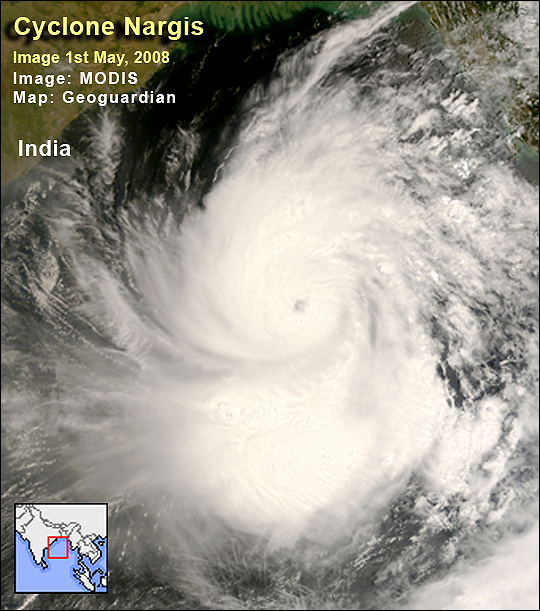
The deadly cyclone Nargis roamed few days over Bay of Bengal and finally slammed into Irrawaddy delta of Myanmar causing devastating damage. According to latest information, already over 240 deaths reported from the Rangoon city and surrounding delta region, when the Nargis hit with wind of 190km per hour. Government has declared affected are as disaster areas while Rangoon international airport was closed for all flights. At early stage clouds belongs to Nargis brought heavy rains to Sri Lanka, killing about 6 people by floods. The NASA’s MODIS satellite image in the figure shows huge cloud formation of Nargis over Bay of Bengal, in 1st of May. Cyclone Narigs became one of the most devastating storms to hit Myanmar in recent years.

Myanmar Disaster
2008/05/11
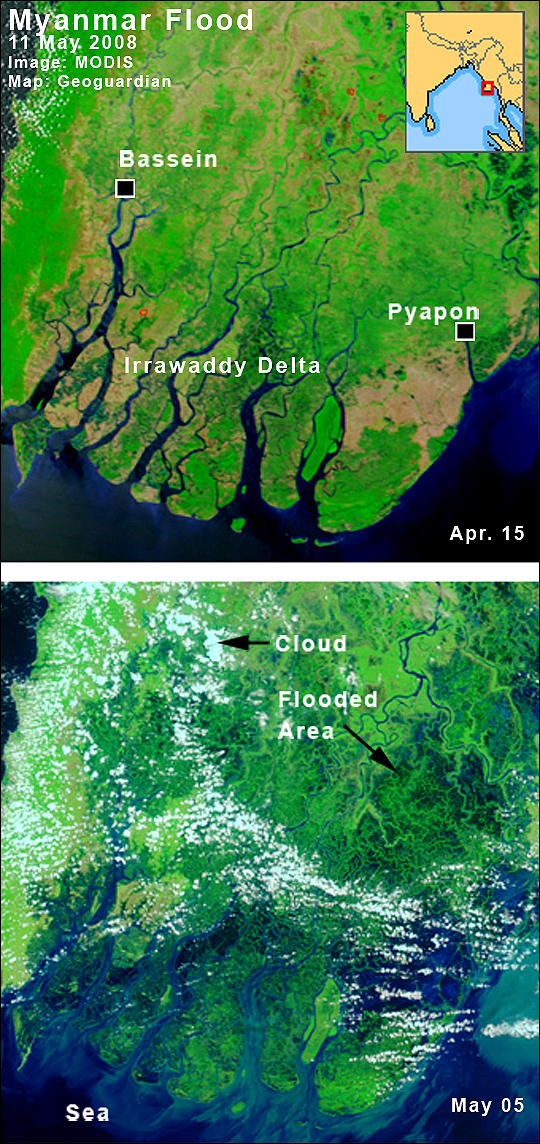
The disaster caused by the deadly cyclone Nargis became one of the worst cyclone disasters in decades. The Myanmar government says the death toll as 23,33 with another 37,000 are missing. But aid agencies predicting the death toll may climb passing 100,000. A huge region of delta has submerged for days increasing the damage and delaying relief efforts. Now, after one week from the disaster, finally aids are reaching to the affected areas through numerous administration problems. These two images are showing flooded river delta area before and after the flood. Black and dark blue areas among green and yellow land are flooded areas.

Deadly Earthquake
2008/05/12
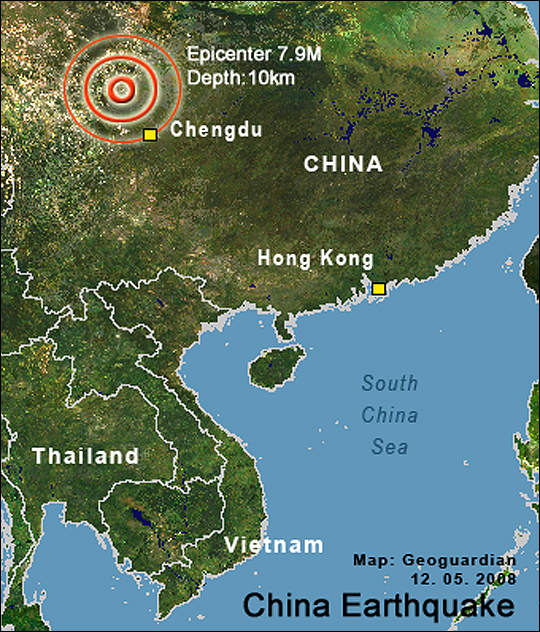
According to Chinese government information a powerful earthquake with 7.9 M hit Beichuan County of mountainous Sichuan province, China, killing thousands of people. The quake hit just below 10km from the surface and buried thousands of people under collapsed buildings. The casualty figure ran high sharply, and by 14th May, touching 15,000. According to local news, only 2,300 of the 10,000 residents in the southwestern town of Yingxiu survived the earthquake. Government started to airdrop aids, as roads were not accessible due to landslides and impact of the quake. Map shows the quake epicenter and report says the devastating shock has felt as far as Vietnam. Sichuan Province, in central southwest is one of the most fertile and agriculturally important areas in China and the third most populous province.

Devastating Indian flood
2008/08/31
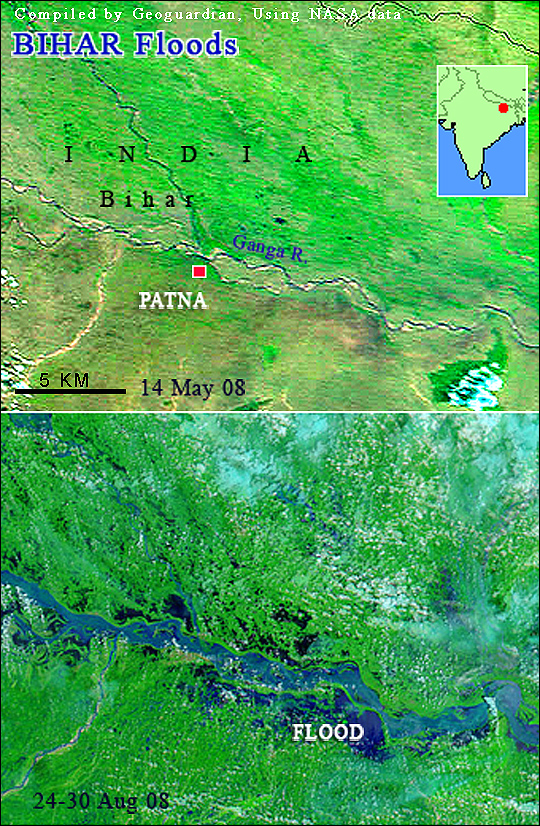
Over 2 million people became homeless in northeast Bihar district in India, after record-breaking flood devastated the region since last week. Indian police said over 70 people died due to flood related incidents so far. Images show clearly the flooded Ganga river valley, in this MODIS satellite image comparison of the composite image of 24 and 30 August image and 14th May clear sky image. About 3 to 5 km wide land strip along the river with hundreds of villages have inundated. Still monsoon thunderstorms are continuing over the area and millions of people have affected in a huge area from north central India to northeast.

Hurricane Ike
2008/09/06
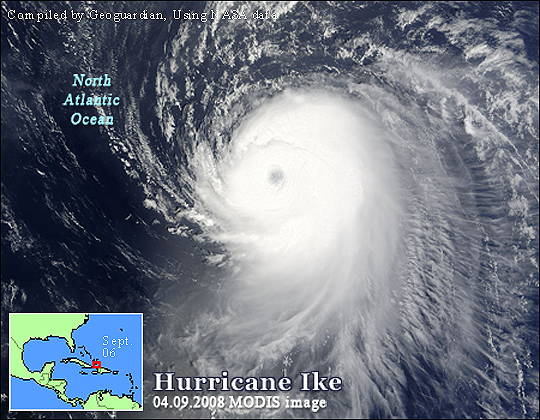
Caribbean region faced number of devastating hurricanes in last few weeks. Aggregating the misery, another extremely dangerous storm, hurricane Ike is now hammering the region. The image shows early stage of the hurricane, recorded by MODIS satellite on 4th Sept. Its today’s location shows on the inserted map. According to weather records, Ike is having 216 km per hour wind speed now (by 7th Sept). Weather forecast indicates Ike’s path, crossing Cuba in next 48h before enter into the Gulf of Mexico. If the hurricane maintains its devastating power, it will force another evacuation of millions of people in the US southern coastal area.

The first global carbon dioxide image
2008/10/14
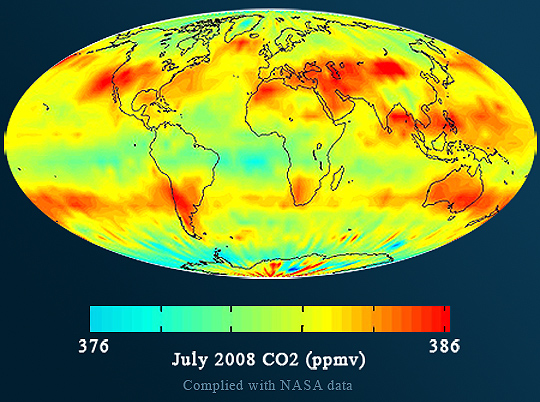
For the first time, a NASA/university research team has produced an image covering entire globe to show the greenhouse gas carbon dioxide in Earth's mid-troposphere, the region about 8 km from the earth surface. This product will help ongoing research works on global warming and climatic change studies. The map shows how carbon dioxide is distributed in the atmosphere and how moved around, during July 2008. Red color shows heavy CO2 concentrations with 386.2 parts per 1 million parts as the highest value. The image was produced with data acquired from AQUA satellite’s AIRS (Atmospheric Infrared Sounder) sensor.

|